
Lowndes County is a county located in the south-central portion of the U.S. state of Georgia. As of the 2020 census, the population was 118,251. The county seat is Valdosta. The county was created December 23, 1825.
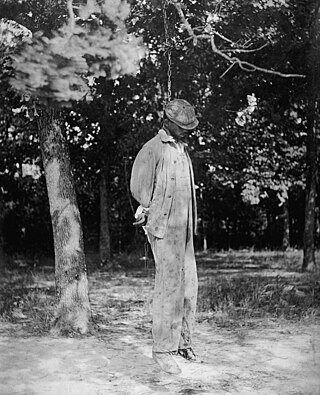
Lynching is an extrajudicial killing by a group. It is most often used to characterize informal public executions by a mob in order to punish an alleged transgressor, punish a convicted transgressor, or intimidate people. It can also be an extreme form of informal group social control, and it is often conducted with the display of a public spectacle for maximum intimidation. Instances of lynchings and similar mob violence can be found in every society.
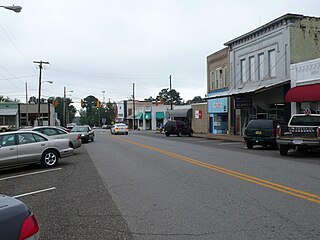
Eutaw is a city in and the county seat of Greene County, Alabama, United States. At the 2020 census, the population was 2,937. The city was named in honor of the Battle of Eutaw Springs, the last engagement of the American Revolutionary War in the Carolinas.
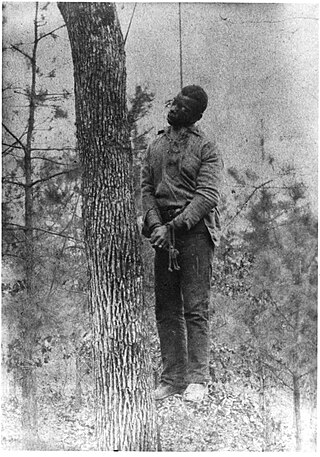
Lynching was the widespread occurrence of extrajudicial killings which began in the United States' pre–Civil War South in the 1830s and ended during the civil rights movement in the 1950s and 1960s. Although the victims of lynchings were members of various ethnicities, after roughly 4 million enslaved African Americans were emancipated, they became the primary targets of white Southerners. Lynchings in the U.S. reached their height from the 1890s to the 1920s, and they primarily victimised ethnic minorities. Most of the lynchings occurred in the American South, as the majority of African Americans lived there, but racially motivated lynchings also occurred in the Midwest and border states. In 1891, the largest single mass lynching in American history was perpetrated in New Orleans against Italian immigrants.

The Pickens County Courthouse in the county seat of Carrollton, Alabama is the courthouse for Pickens County, Alabama. Built-in 1877-1878 as the third courthouse in the city, it is noted for a ghostly image that can be seen in one of its garret windows. This is claimed to be the face of freedman Henry Wells from 1878.

Jesse Washington was a seventeen-year-old African American farmhand who was lynched in the county seat of Waco, Texas, on May 15, 1916, in what became a well-known example of lynching. Washington was convicted of raping and murdering Lucy Fryer, the wife of his white employer in rural Robinson, Texas. He was chained by his neck and dragged out of the county court by observers. He was then paraded through the street, all while being stabbed and beaten, before being held down and castrated. He was then lynched in front of Waco's city hall.
Roy Belton was a 19-year-old white man arrested in Tulsa, Oklahoma with a female accomplice for the August 21, 1920 hijacking and shooting of a white man, local taxi driver Homer Nida. He was taken from the county jail by a group of armed men, after a confrontation with the sheriff, and taken to an isolated area where he was lynched.
On May 16, 1918, a plantation owner was murdered, prompting a manhunt which resulted in a series of lynchings in May 1918 in southern Georgia, United States. White people killed at least 13 black people during the next two weeks. Among those killed were Hazel "Hayes" Turner and his wife, Mary Turner. Hayes was killed on May 18, and the next day, his pregnant wife Mary was strung up by her feet, doused with gasoline and oil then set on fire. Mary's unborn child was cut from her abdomen and stomped to death. Her body was then repeatedly shot. No one was ever convicted of her lynching.

Laura and L. D. Nelson were an African-American mother and son who were lynched on May 25, 1911, near Okemah, Okfuskee County, Oklahoma. They had been seized from their cells in the Okemah county jail the night before by a group of up to 40 white men, reportedly including Charley Guthrie, father of the folk singer Woody Guthrie. The Associated Press reported that Laura was raped. She and L. D. were then hanged from a bridge over the North Canadian River. According to one source, Laura had a baby with her who survived the attack.

In Forsyth County, Georgia, in September 1912, two separate alleged attacks on white women in the Cumming area resulted in black men being accused as suspects. First, a white woman reportedly awoke to find a black man in her bedroom; then days later, a teenage white woman was beaten and raped, later dying of her injuries.

The Longview race riot was a series of violent incidents in Longview, Texas, between July 10 and July 12, 1919, when whites attacked black areas of town, killed one black man, and burned down several properties, including the houses of a black teacher and a doctor. It was one of the many race riots in 1919 in the United States during what became known as Red Summer, a period after World War I known for numerous riots occurring mostly in urban areas.
Matthew Williams was a black man lynched by a white mob in Salisbury, Maryland on December 4, 1931.
The lynching of Willie Earle took place in Greenville, South Carolina on February 16, 1947, when Willie Earle, a 24-year-old black man, was arrested, taken from his jail cell and murdered. It is considered the last racially motivated lynching to occur in South Carolina. The subsequent trial gained much media attention, and was covered by Rebecca West for The New Yorker. The trial resulted in the acquittal of 31 white men who had been charged with Earle's murder.
Ephraim Grizzard and Henry Grizzard were African-American brothers who were lynched in Middle Tennessee in April 1892 as suspects in the assaults on two white sisters. Henry Grizzard was hanged by a white mob on April 24 near the house of the young women in Goodlettsville, Tennessee.
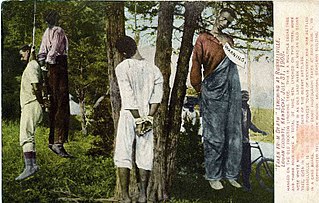
A lynching postcard is a postcard bearing the photograph of a lynching—a vigilante murder usually motivated by racial hatred—intended to be distributed, collected, or kept as a souvenir. Often a lynching postcard would be inscribed with racist text or poems. Lynching postcards were in widespread production for more than fifty years in the United States; although their distribution through the United States Postal Service was banned in 1908.
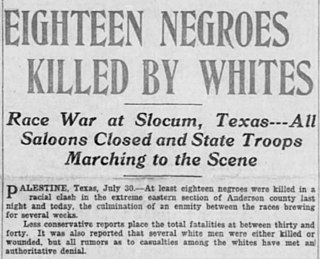
The Slocum Massacre occurred on July 29–30, 1910, in Slocum, Texas, an unincorporated community in Anderson County near Palestine in East Texas. Only six deaths were officially confirmed, but some 22 were reported by major newspapers. This is the official count, and it is estimated as many as one hundred African Americans were killed.
The lynching of George Hughes, which led to what is called the Sherman Riot, took place in Sherman, Texas, in 1930. An African-American man accused of rape and who was tried in court died on May 9 when the Grayson County Courthouse was set on fire by a White mob, who subsequently burned and looted local Black-owned businesses. Martial law was declared on May 10, but by that time many of Sherman's Black-owned businesses had been burnt to the ground. Thirty-nine people were arrested, eight of whom were charged, and later, a grand jury indicted 14 men, none for lynching. By October 1931, one man received a short prison term for arson and inciting a riot. The outbreak of violence was followed by two more lynchings in Texas, one in Oklahoma, and several lynching attempts.

A mob of white Vigo County, Indiana residents lynched George Ward, a black man, on February 26, 1901 in Terre Haute, Indiana, for the suspected murder of a white woman. An example of a spectacle lynching, the event was public in nature and drew a crowd of over 1,000 white participants. Ward was dragged from a jail cell in broad daylight, struck in the back of the head with a sledgehammer, hanged from a bridge, and burned. His toes and the hobnails from his boots were collected as souvenirs. A grand jury was convened but no one was ever charged with the murder of Ward. It is the only known lynching in Vigo County. The lynching was memorialized 120 years later with a historical marker and ceremony.

On October 11, 1878, Jim Good, Jeff Hopkins, Ed Warner, William Chambers, and Dan Harris, Sr. were lynched in Posey County, Indiana, near the town of Mount Vernon. These men, who were allegedly connected to the robbery of a brothel, were killed by a white mob who broke into the jail where they were being held. Two other men, Dan Harris, Jr. and John Harris, were also lynched in the days leading up to October 11, in connection with the same alleged offense. This racial terror lynching is the largest reported lynching in Indiana's history.














